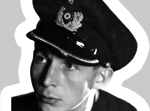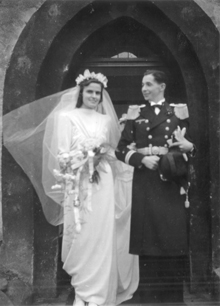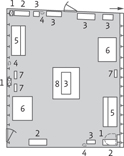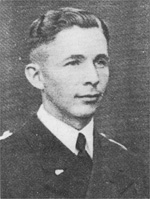| |
 |
|
|
|
| |
 |
Sub-Lieutenant
Friedrich Cardinal
I. Communication Officer Main Artillery
* 30.9.1910 in Heiligenhaus (Rhine Province) - † 27.5.1941
|
 |
|
|


Germany (1910)
Sources:
Otto Schlenzka † (Crewmate) / Kiel
Josef Statz †
Crewbook of the Crew 37 A
Ranglisten of the Kriegsmarine
|
Friedrich Cardinal was born on September 30, 1910 in the small Rhineland town of Heiligenhaus. The town is located in the triangle of cities between Düsseldorf, Essen and Wuppertal in the Niederbergisches Land, a more rural area compared to the heavily populated surroundings. But Friedrich Cardinal was drawn to the world and so he joined the Navy. After a career as an enlisted soldier and non-commissioned officer, he was given the opportunity to train as an officer. This career jump was only made possible for a few soldiers from the non-commissioned officer rank and required very special achievements and aptitude. Friedrich Cardinal seized the opportunity and, promoted directly to midshipman in 1938, joined the already running Crew 37 A. He was able to skip the common basic and on-board training of officer candidates — which he had already experienced in his previous career. His training as an officer began at the Mürwik Naval Academy. He was the oldest in his crew and so it happened that he shared a room with his youngest crewmate, Otto Schlenzka, to support him and from then on worked together as a team. The two quickly became close friends. At the end of their officer training, they both sailed together on the Admiral Scheer, where they shared a post. Friedrich Cardinal later went to the battleship Bismarck, where he served as the first comunication officer of the main artillery in the forward artillery calculation center.
|
|
|
1 The gun turret Bruno was intended as a reserve ship's command post because it was well armored and offered a view to the front. For this purpose, an engine telegraph transmitter, turn indicator, rudder telegraph transmitter and a secondary compass were installed in the turret.
|
 On April 7, 1941, he married his fiancée Ursula Gregor, who came from Berlin, in the capital of the Reich. His good friend and crewmate Otto Schlenzka, who was serving as anti-aircraft section leader on the Prinz Eugen at the time, accompanied him as best man. At about the same time, Josef Statz, who later survived and was then Stoker, 2nd Class, also came on board the Bismarck. He later remembered his first meeting with Friedrich Cardinal clearly. During a battle training, Josef Statz was deployed as a messenger in the leak control center. As such, he had to bring a report to the ship's command, which was now located in the Bruno gun turret after the assumed failure of the forward ship's command post1. When he arrived there, he went to the captain and wanted to report, but the captain did not react at all. "Don't you see, the captain is dead!" someone shouted at him. "But the captain is still standing!" Josef Statz replied, astonished, and looked at Lindemann, who, despite all outward signs of indifference, had a mischievous smile on his face. "Well, Tünnes, are you from Cologne?" asked the same voice, it was that of Friedrich Cardinal, a Rhinelander like Statz. "Give me the report and come to the bridge!" he continued. Everyone else around was considered dead and so they stood all alone on the bridge. Josef Statz was now able to make his report and Friedrich Cardinal explained to him: "All men who are to be considered dead wear their caps sideways. That way they can be recognized as quickly as possible, you must remember that!"
On April 7, 1941, he married his fiancée Ursula Gregor, who came from Berlin, in the capital of the Reich. His good friend and crewmate Otto Schlenzka, who was serving as anti-aircraft section leader on the Prinz Eugen at the time, accompanied him as best man. At about the same time, Josef Statz, who later survived and was then Stoker, 2nd Class, also came on board the Bismarck. He later remembered his first meeting with Friedrich Cardinal clearly. During a battle training, Josef Statz was deployed as a messenger in the leak control center. As such, he had to bring a report to the ship's command, which was now located in the Bruno gun turret after the assumed failure of the forward ship's command post1. When he arrived there, he went to the captain and wanted to report, but the captain did not react at all. "Don't you see, the captain is dead!" someone shouted at him. "But the captain is still standing!" Josef Statz replied, astonished, and looked at Lindemann, who, despite all outward signs of indifference, had a mischievous smile on his face. "Well, Tünnes, are you from Cologne?" asked the same voice, it was that of Friedrich Cardinal, a Rhinelander like Statz. "Give me the report and come to the bridge!" he continued. Everyone else around was considered dead and so they stood all alone on the bridge. Josef Statz was now able to make his report and Friedrich Cardinal explained to him: "All men who are to be considered dead wear their caps sideways. That way they can be recognized as quickly as possible, you must remember that!"
|
|
|

Forward artillery
calculation center
(Mittleres Plattformdeck, Abt. XV m)
1 |
Fan |
2 |
Switchboard |
3 |
Machine |
4 |
Heater |
5 |
Shot data calculator |
6 |
Directional and altitude wise receiver |
7 |
Firesignal transmitter |
8 |
Table |
|
On May 5, 1941, Hitler, accompanied by his naval adjutant Karl Jesko von Puttkamer and Field Marshal Wilhelm Keitel, inspected the Bismarck and Tirpitz. After inspecting the crew who had assembled on the upper deck, the group was led through several rooms inside the ship. The visitors spent a particularly long time in the aft artillery calculation center, where Friedrich Cardinal explained the technical equipment and the complex interaction of the fire control in detail, to the admiration of those present. For him, this was certainly one of the highlights of his career. He told his friend Otto Schlenzka about the visit and how Hitler's technical understanding had amazed him. A short time later, the first mission together with the Prinz Eugen followed and so the two friends, although on different ships, set off on the same mission.
On the evening of May 24, 1941, their paths finally parted. While the Bismarck attempted to escape directly to France, the Prinz Eugen was to pull the enemy ships south in a diversionary maneuver and then use its superior speed to set off and hunt merchant ships independently after resupplying from a tanker. Otto Schlenzka on the Prinz Eugen followed the news about the Bismarck with fascination. He finally learned from radio messages about the fatal torpedo hit and the hopeless situation his friend found himself in with the Bismarck.
We know from the later survivor Burkard Freiherr von Müllenheim-Rechberg that Friedrich Cardinal had given him control of the fire for the aft heavy gun turrets after the early failure of the main artillery fire direction center and the Anton and Bruno turrets.
Josef Statz reported on his further fate. After the first officer ordered the ship to scuttle and abandon ship, Statz climbed through the cable shaft from the leak control center to the forward conning tower and found Friedrich Cardinal there. The ongoing shelling had caused severe damage all around. Josef Statz and Friedrich Cardinal were the only people still alive there. They moved back and forth on the lower mast deck to find cover from the incoming shells. The otherwise lively Friedrich Cardinal had become quiet and only responded to Josef Statz's questions with a slight nod. Both eventually went to the starboard side of the forward conning tower, as the hits were increasingly concentrated on the port side. The door to the conning tower was torn open and light was shining through holes in the back of the stand. With the words "No, no, don't go in!" Friedrich Cardinal stopped Josef Statz. These were to be his last words.
They then continued aft to the starboard anti-aircraft fire direction center, where thick black smoke, caused by fires and the now uncontrolled combustion in the boiler rooms, blocked the view aft. There was no way through. So the two of them took cover again at the forward bulwark. "Gas!" someone shouted from the bridge deck. Immediately afterwards a shell hit and it became quiet. In a short pause between the impacts both of them cast a glance over the bulwark at the forecastle, which was badly scarred by the battle. At this sight, Friedrich Cardinal had tears in his eyes, Josef Statz remembers.
 When the battleships finally stopped firing and only HMS Dorsetshire continued firing, Josef Statz and Friedrich Cardinal went to the port side of the lower mast deck. Here Josef Statz discovered a rope ladder. The two carefully walked towards the ladder, climbing over debris. Friedrich Cardinal was the first to climb the ladder, but he immediately fell one deck lower. The mooring knot had burned through. The two then made their way down to the superstructure deck. Further aft they jumped onto the ceiling of the 15 cm port II turret. Water was already lapping around its barbette on the upper deck. It was time to leave the ship. Without saying goodbye, Friedrich Cardinal was the first to jump into the stormy sea after waiting for a favorable moment and was carried away by the current. After looking back, Josef Statz also jumped into the water and swam towards Friedrich Cardinal. To his horror, he then noticed that his head was hanging limply in the water. Friedrich Cardinal had obviously carried a pistol with him and had taken his own life. The terrible experiences of the last few hours were probably too much for him and the prospect of rescue was too small. Friedrich Cardinal died at the age of 30.
When the battleships finally stopped firing and only HMS Dorsetshire continued firing, Josef Statz and Friedrich Cardinal went to the port side of the lower mast deck. Here Josef Statz discovered a rope ladder. The two carefully walked towards the ladder, climbing over debris. Friedrich Cardinal was the first to climb the ladder, but he immediately fell one deck lower. The mooring knot had burned through. The two then made their way down to the superstructure deck. Further aft they jumped onto the ceiling of the 15 cm port II turret. Water was already lapping around its barbette on the upper deck. It was time to leave the ship. Without saying goodbye, Friedrich Cardinal was the first to jump into the stormy sea after waiting for a favorable moment and was carried away by the current. After looking back, Josef Statz also jumped into the water and swam towards Friedrich Cardinal. To his horror, he then noticed that his head was hanging limply in the water. Friedrich Cardinal had obviously carried a pistol with him and had taken his own life. The terrible experiences of the last few hours were probably too much for him and the prospect of rescue was too small. Friedrich Cardinal died at the age of 30.
|
|
|